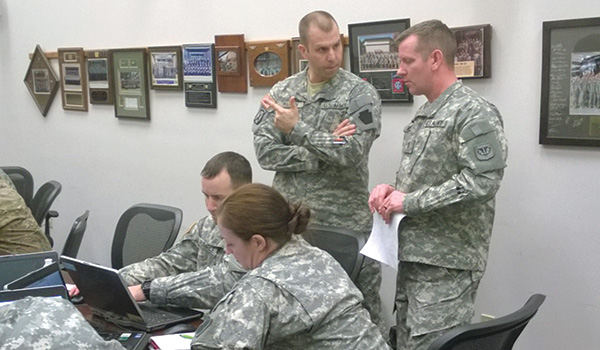
CWOB – IERW Training and AWOAC / By CW5 Dennis E. Smith: I am frequently asked about the quality of an aviator that returns to your formations from flight school. In response, I normally recite accolades from typical application packet letters of recommendation written by senior leaders. Most letters include the statement, “I highly recommend this candidate!”

AWOAC-RC Class 16-002 small group planning during their Division Exercise Training and Readiness System (DXTRS) exercise./ U.S. ARMY PHOTO
It is logical to conclude that adding the world’s best rotary wing flight training to a highly recommended candidate should equate to a competent entry-level aviator. Sometimes that logic does not hold true and we end up losing students who have started Initial Entry Rotary Wing (IERW) training but fail to complete it. This loss comes at an enormous expense on so many levels to both individual units and the Army National Guard as a whole. I have discovered that some very effective Reserve Component (RC) organizations have sponsorship programs to stay connected with their IERW students. These students receive constant communication and even quarterly in-person meetings with a command representative. The opposite is also true – most struggling students have little to no contact with their state or unit and feel isolated or even deserted. I encourage you to stay involved with your investment. The RC Team at USAACE can assist in many ways, ranging from special emphasis physical fitness training to collective or even individual academic tutoring. The primary point of contact for the RC team is the TRADOC RC Liaison Office at 334-255-1216.
Is 95% Good Enough?
Program of Instruction (POI), as well as prerequisite changes for Aviation Warrant Officer Advanced Course-Reserve Component (AWOAC-RC) are here, and many more are coming. Over the course of the past two years, the outdated two-week resident portion of the RC course (Phase II) has been drastically changed in an attempt to keep up with changes to the 54-day resident course. The Distance Learning (DL) modules (Phase I) are currently under revision and are projected to be completed this fiscal year (FY). The new Midgrade Learning Continuum (MLC) DL course mandated by the Combined Arms Center is also projected to be added in FY19.
During the ramp-up of IERW training from 2007-2009, the RC had significant increases in flight school quotas. Unfortunately, this increase in WO1s attending flight school did not automatically translate to an increased number of AWOAC seats seven years down the road. Phase II has historically been conducted three times each fiscal year (FY), with 45 seats in each class. According to data-pulls and Command Chief Warrant Officer (CCWO) comments, 135 total seats per year are far less than the number of warrant officers requiring the training.
To help eliminate the backlog, the National Guard Bureau and USAACE worked together to add two additional classes in 2014, each with 45 seats. The fill rate began at 81%, but improved to 90%. Unfortunately, those percentages were driven down by preventable seat-losses in each class due to Army Physical Fitness Test (APFT) and/or height/weight failures.
We analyzed the issue and discovered additional problems were created by the course prerequisites listed in the Army Training Requirements and Resources System (ATRRS). Phase I had to be completed within 180 days of Phase II and students were not willing to gamble by taking the DL without a reservation in Phase II. As a result, we had no bench of Soldiers who were DL complete and available to take shortfalls to Phase II. The 24-month time-in-grade requirement was also removed, which opened the course to all CW2s who had completed the DL to help fill vacancies. The current requirement in ATRRS now mandates all prerequisites be completed 60 days before the start day of Phase II. Students who do not meet the 60-day requirement lose their reservation and this change has afforded units more time to prepare to capitalize on shortfalls. As a result, 95% of seats were filled in FY15 and 100% of seats have been filled in FY16.
Now that we know how to get them here, let us make sure we are getting the right ones here. The Guard has lost additional seats to APFT and/or height/weight failures in FY15 and FY16. We had, or have had, over twenty students in a wait status for each class in FY16. Some Soldiers even travel to the school for each report date, in hopes of getting a shortfall. While a 95% success rate looks great on most reports, it doesn’t look good to those denied promotion because they are unable to secure a seat in the course. Even the loss of one seat is too much in this time of extremely constrained resources.
Until the upcoming course changes are implemented, please help us maximize enrollments in the existing courses in FY16 and the additional courses added in FY17, by ensuring students are prerequisite complete, are within height/weight standards, can pass an APFT, have a valid security clearance, and are registered for the correct Branch Warrant Officer Advanced Course.
“Above the Best!”
CW5 Dennis E. Smith is the U.S. Army Aviation Center of Excellence (USAACE) Army National Guard Senior Warrant Officer Advisor. CW5 Allen R. “Randy” Godfrey is the chief warrant officer of the Aviation Branch with the U.S. Army Aviation Center of Excellence, Fort Rucker, AL.







